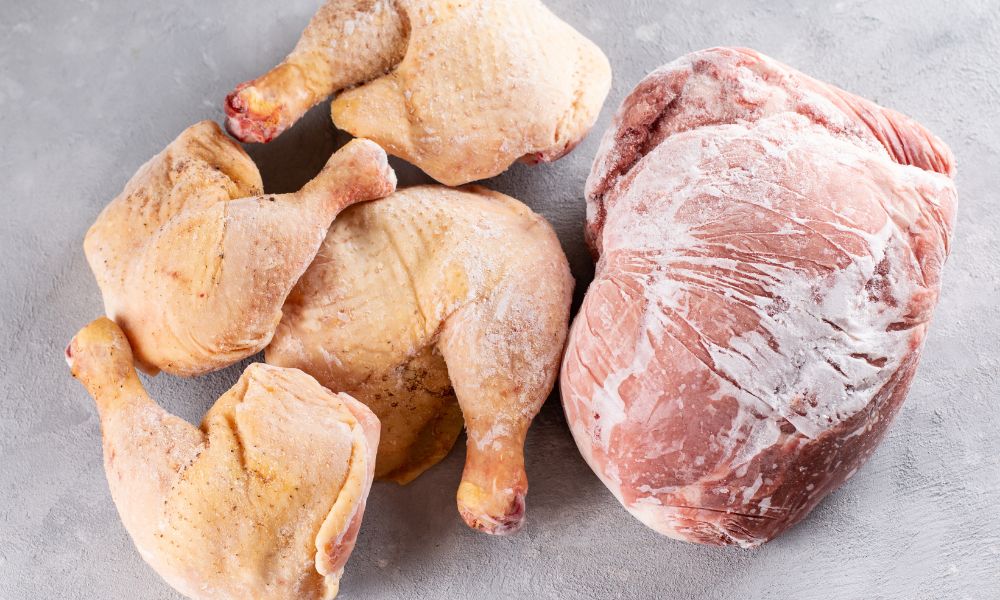Everyone has faced a situation where they find themselves with extra chicken that needs to be stored for future meals. The solution: freezing chicken. Freezing chicken is an effective way to prolong the shelf life of your chicken, saving you time on future meal prep and money on wasted food. In this guide, we’ll explore the ins and outs of freezing chicken, including recommended freezing times, tips for maintaining quality, and answers to some frequently asked questions about freezing chicken.
Understanding Freezing Times for Chicken

Before we dive into the freezing process, let’s understand the recommended freezing times for different cuts of chicken. The length of time you can freeze chicken depends on the cut and whether it’s cooked or raw. Here are some general guidelines:
- Whole chicken (raw): up to 12 months
- Chicken pieces (raw): up to 6 months
- Ground chicken (raw): up to 3 months
- Cooked chicken (whole or pieces): up to 3 months
It’s important to note that these are only guidelines, and the actual freezing time may vary depending on the quality of the chicken and how well it’s packaged.
When it comes to frozen chicken, texture, flavor, and safety are crucial. While freezing doesn’t affect food safety, it may impact the chicken’s texture and flavor, especially when stored for extended periods. Over time, chicken may become dryer, lose some flavor, and develop a rather “off” taste. That’s why it’s essential to follow proper packaging and labeling techniques when freezing chicken. Keep in mind that the freezer’s temperature should be maintained at 0°F or lower to ensure optimal freshness.
Factors Affecting Frozen Chicken Quality
Now that we understand freezing times, let’s explore how certain factors may affect the quality and safety of frozen chicken. By addressing these factors, we can minimize negative impacts on our chicken and keep it fresh and flavorful.
Freezer Temperature
The temperature at which you store your frozen chicken has a lot to do with the quality of the chicken. A temperature of 0°F or below is necessary for preventing bacterial growth and ensuring the quality and safety of the chicken. It’s good practice to check the temperature of your freezer periodically to make sure it’s within the proper range.
Freezer Burn
Few people haven’t experienced the disappointment of opening the freezer to find their once-juicy chicken coated with a layer of ice crystals. This phenomenon, called freezer burn, occurs when moisture evaporates from the food, leaving behind a dry, unappetizing texture. While it won’t make the chicken unsafe to eat, freezer burn can negatively affect the taste and texture.
To prevent freezer burn, it’s essential to use airtight containers or freezer bags to store chicken. There are also specific freezer food wraps available in supermarkets that work well for freezing chicken. Proper packaging techniques will help maintain the chicken’s freshness and reduce the risk of freezer burn.
Airtight Containers and Freezer Bags
As mentioned earlier, using airtight containers or freezer bags is crucial for maintaining the quality of your frozen chicken. Proper packaging not only preserves the original flavor and texture of the chicken but also helps prevent any odors or flavors from other foods from affecting it. Furthermore, these storage methods keep the chicken safe from the growth of any harmful bacteria or pathogens.
Tips for Properly Freezing Chicken

Now that we’ve covered the factors affecting quality and safety, let’s dive into a step-by-step guide on properly freezing chicken to ensure optimal freshness.
- Wash and dry the chicken: Before freezing, make sure to thoroughly wash and pat dry the chicken using paper towels. Removing excess moisture helps to preserve the texture and flavor while reducing the chances of freezer burn.
- Cut and trim the chicken: Cut and trim your chicken into desired portions before freezing. This helps to save space in the freezer and allows for more efficient defrosting later on. For reference, use this guide to cutting a whole chicken into pieces.
- Prepare the packaging: Choose your preferred packaging method, either airtight containers or freezer bags. If using freezer bags, use heavy-duty bags specifically designed for freezing. These bags are thicker and more resistant to punctures and leaks.
- Wrap and seal the chicken: Place individual pieces of chicken into the bag or container, being careful to keep them in a single layer. If using freezer bags, press out as much air as possible before sealing the bags. Removing excess air is essential for minimizing freezer burn and maintaining the freshness of the chicken.
- Label the packages: Label each package with the date of freezing and the type of chicken (e.g., whole, thighs, breasts), as well as any seasoning or marinade if applicable. This will help you keep track of what’s in your freezer and ensure that you’re not storing chicken for longer than the recommended freezing times.
With these tips, you’ll be able to achieve the ultimate goal of maintaining the original flavor, texture, and safety of your frozen chicken.
Storing Frozen Chicken
Our freezing journey doesn’t end with just packaging the chicken. Proper storage in your freezer plays a significant role in preserving the quality and safety of your chicken. Here’s how to store frozen chicken effectively:
- Set the freezer temperature: As discussed earlier, the ideal freezer temperature should be 0°F or lower. This ensures that the chicken remains safely frozen and free from bacterial growth. Regularly checking and maintaining the temperature is crucial for keeping the chicken in the best condition.
- Organizing your frozen chicken: Don’t just throw your chicken packages haphazardly into the freezer. Instead, organize them in a way that makes it easy to access and locate what you need. Consider using bins or baskets to separate different types of cuts or foods for better organization.
- Labeling: Make sure to properly label each package with the date of freezing and the type of chicken, to ensure that you use older chicken before it reaches the end of its optimal storage time. Labeling also helps prevent any confusion when it’s time to select chicken for your next meal.
By following these storage tips, you’ll be well on your way to having a well-organized, efficient, and quality-preserving freezer filled with delicious chicken.








